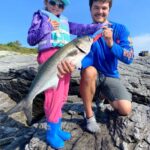Seventy-five casts to your sweet spot should tell you all you need to know: either you’ve hit the lottery or you’re working in a desert. That’s one successful local angler’s theory about striper fishing this time of year and there’s definitely something to it. After waiting so very long for sunny skies and southwest winds, it looks like the waters are warming up and schoolie bass draped in sea lice are finally migrating north. Up in the Bay, some skittish squid seem to be making sporadic appearances, moving in and out with slight changes in water temperatures. With spring weather being so fickle, knowing your destinations water temperature is critical. When fishing for stripers, if the sea water is 45 and the forecast is rain, it’s a great time to pay a visit to Sarah the bartender at Fat Belly’s instead of just getting wet. Fishing in the rain really separates the men from those smart enough to stay indoors when it’s raining.
Seasoned fishermen certainly have preferences for bass: soft baits or hard plastics, black Sluggo’s anytime or only when it’s dark as a pocket, but to finally get something in your log book, a Cocahoe minnow on ¼ or ½ oz. jig head might just be your safest bet. Longtime surf pro Steve McKenna recommends a Red Gil teaser tied ahead of your lure, which is excellent advice.
On the pond front, Mike Yarworth landed a few nice largemouth’s in shallow waters on green Stick-o’s along with some decent sized pickerel. A black over white broken back minnow landed a nice bass for the guy next to him so the freshwater bass bite is definitely strong in the warm waters.
Water temperature is the deciding factor for most sea life when it comes to feeding and moving. This year, upper Narragansett Bay waters were in the very low forties with South County waters in the high thirties when the river herring arrived. As striped bass have a lower tolerance of around fifty and prefer the 55-65 degree range, it’s obvious why the bite is just starting to get going.
Tautog fishing started off slowly in cold waters because 45 is the bottom end of their temperature tolerance and they would much rather feed in the 50-60 range. For many, bluefish catches were down last year and we won’t get another look at them until the waters warm up to around 65-72. Fluke show up when the number hits 56 or so and are most comfortable from 62 to 70. The appearance over the last few summers of non-native southern fishes shows how streams of warm waters are shifting northward, carrying along some migrating fish.
Speaking of, Saturday, May 24 is World Fish Migration Day. Celebrated from sunrise in New Zealand to sunset in Hawaii, and in conjunction with The Nature Conservancy and other similarly intentioned organizations, the goal is to raise awareness of a family of fishes naturally on the move and their critical roles in the marine ecosystem. Salmon trout sturgeon shad striped bass eel and river herring are some of our local species whose river passages far predates our jamming up natures’ gears in pursuit of power and wealth. Over-harvesting, pollution and dams are impeding the travels of fishes who, whether dead or alive, help feed our planet.
Because Man is generally reactive, we tend to identify magnificent Natural events and their significance to other animals and our wallets but not foresee problems until it’s almost too late. It’s fish in a barrel, man. Shoot all the fish in the barrel and pretty soon you’re left with nothing but stories about how deep the barrel used to be and how much shooting you once did. Our National Marine Fisheries Service has identified a 65 per cent decline in recreational striped bass landings in the last seven years. Numbers of stripers caught, both kept and released alive, have dropped from approximately 26 million to 9 million. Most of us have stories about the fish we used to catch.
Strong numbers of these migratory fish helps ensure circularity. On the left coast, Pacific salmon expire after spawning, providing essential nutrition to scavengers and other salmon as their nitrogen and phosphorus feeds shore-side trees. Nature transports the ocean’s fertility all the way to fresh water rivers. Our Atlantic salmon muscle their way far up rivers to relatively calm gravel beds and areas of low predation, ideally heading downstream post-spawn. Their return to the sea increases population potential because they will return to spawn again. Fantastic.
According to Professor John Waldman at CUNY, a single dead mature buckeye contributes one-half gram of organic phosphorus to the watershed. A successful spawner who returns to the sea, adds approximately one-third of that. They deposit essential minerals from productive offshore waters to our rivers and streams which can suffer mineral depletion, more profoundly after periods of heavy rains and snowmelts. This matters because with robust numbers of returning alewives, we would see a partial return to the natural ecosystem balance we once enjoyed but were too busy eviscerating to respect.
It’s just a giant circle. Small numbers of protein and mineral-rich migratory and forage fishes returning to rivers means less spawning success, which means fewer nutrients for trees, birds, terrestrial animals and larger fish. That equals less predatory fish like blues, swordfish, marlin and striped bass and more sleep for us since there will be no reason to stay out fishing all night.
So that’s why we need to celebrate the migration. Connecticut has sixteen events planned, from Bridgeport to East Berlin. Closest for us are tours of fish ladders and streams of diadramous fishes in the Old Lyme area. Unfortunately there are no such events scheduled for our state. Our motto is Hope, not Proactive. If you have the time or compunction, it might be worth the drive on May 24 to see what this day is all about. Maybe next year we will drive or even walk to one of our own fantastic rivers to celebrate the mighty migratory fish.





0 Comments